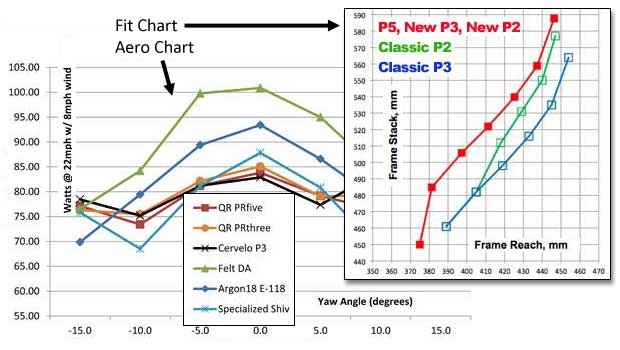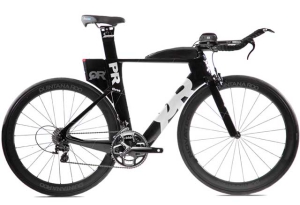Let’s talk about the 2018 edition of Cervelo’s P2. You know my thesis, right? That there are some complete bikes in the $2,500 to $3,000 price category good enough as platforms aboard which – with a little dolling up – you can win an Ironman. Even the Big One.
Of course you’re going to need a little help. Genetics. Training. Some luck. But the bike won’t hold you back. As to that dolling up, what are we talking about? Not much! Some race wheels. Some race tires. Do-dads like a front hydration system. That’s it! Oh, and a little bell, for when you’re getting ready to pass somebody on the left.

I call this class of bike Entry Level Plus. Below is one such bike.
Cervelo P2
Here’s how this bike came about. First there was the P3C (C for carbon). This was Cervelo’s breakthrough bike. It came along around 2005 as I recall, following its P3 aluminum, which followed its P2SL and before that the P2K, which was for sale just before the turn of the century. The carbon version of the P3 was a game changer. A life changer. It was probably more consequential to triathlon cycling than anything I ever did.
Now, here’s the thing about that Cervelo P3C. It was what we call “long and low” geometrically, meaning it was a missile with footpegs. A lot of people couldn’t get that low. Cervelo needed two things: a cheaper carbon bike; and a taller bike. Enter the P2C. (Look at the Cartesian graph below for the precise differences in fit.)
In 2007 these bikes simply became the P2 and P3, the C was dropped, when Cervelo dropped aluminum from its lineup.
In 2008 Chrissie Wellington won the Hawaiian Ironman on a P2, and since that time it’s really been obvious to anyone closely observing with an unbiased, fact-based mind that a $10,000 bike is not a requirement for a top tier performance.

Finally Cervelo decided to retire the old P3 mold and remake it into a taller bike (taller even than the original P2), to fit more of the fat of the market (no pun intended). The new P3 was unveiled in April of 2013. It took a trained eye to perceive the difference between the new and the old P3. The geometry changed. Not much more, except for some routing help for Di2 and a few minor whizbangs.
In 2014, just 8 months after the new P3 with reworked geometry was introduced, the new P2 debuted. The P2 and P3 now share the same frame. The forks differ a little, just as the forks on Quintana Roo’s PRfive and PRsix are the differentiators on bikes that share the same frame.
Great Minds Think Alike
Yesterday I published on Quintana Roo’s PRthree. That bike sells for a buck under $2,600. This bike I’m writing about today sells for $2800. Just look at how close these bikes are to each other. They are each Shimano 105 bikes, and they each have Shimano RS010 wheels. Here’s what’s better about the P2: the front derailleur. It’s 5801 is slightly better than the 5800 on the QR. On the other hand, I like the ISM PR2.0 saddle (spec’d on the QR) a little more than the PR1.0 spec’d on the P2. They each have 11-28 cogsets on the back; the Cervelo specs a 50x34 chain ring set instead of QR’s 52x36.

Both bikes spec Profile Design’s T4 aluminum extensions on a J2 bracket topped with an F35 armrest. The shifters differ: Cervelo plays it safe with Shimano bar end shifters; QR goes with Micro Shift, and a lot of folks like the Micro Shift better. But it’s not Shimano. My choice? They each work fine.
It’s my view that we all should take comfort when we see convergence around a platform or paradigm. When two august bike makers like Cervelo and Quintana Roo make the best bikes they can make in this category, and those bikes end up sharing so much, and are priced similarly, it creates a motif that should act as an industry touchstone.
Power meter Choice
The Cervelo uses a Shimano RS510 crankset, and I think it’s in the crank that some folks might find a more meaningful difference between these two bikes. What are you going to use for a power meter? The answer to this question may inform your decision between these bikes. Do you need a 5-bolt, 110mm bolt pattern crank? The Powertap C1 is compatible with the Gossamer Pro BB368EVO crankset, which is (as well as I can tell) the crank that comes on the PRfive. Can’t put Powertap C1 on Cervelo’s crank.

What about Pioneer power meter? Wow. Don’t know. Cervelo’s crank shares the 4-bolt profile of the 105 cranks that Pioneer is compatible with. Pioneer mates with FSA’s SL-K crank but I haven’t heard that it yet works with the Gossamer Pro spec’d on the PRthree. I’ll need to research that. The point is, this is how close these bikes are, that we’re talking about power meter compatibility as the driver of bike choice.
Cosmetics
There are two new colorways: grey with lime highlights; and navy with red highlights. These are in the attached photos. Now, I haven’t seen these colorways in the flesh or, if I saw them at Interbike, I forgot what they looked like. In the photos I can’t see the difference in the base color, so either I’ve become colorblind or both the navy and the grey are quite dark.
When I owned a bike company my employees knew when to put their feet down, such as when it came time to bike colors (they stopped letting me choose). Me, as a businessman, I most admire Bianchi, which somehow got its buying public to sit still for one color, all the time, every time, every year. How easy would my life have been? At a certain point I learned to adopt the Felt habit of saying, “You can choose whatever color you want, as long as the other color choice is black.” You can’t go wrong with black. All of which is to say, I am the wrong guy to opine on cosmetics.
Aerodynamics
In QR’s own testing it shows Cervelo’s P3 as very slightly slipperier than the PRthree or PRfive, except at yaws (10° and 15°) fairly rarely experienced in bicycle racing.

I suspect these bikes are pretty similar, but I guess I would give the slight nod to Cervelo only on tradition, history, bona fides. Experience has taught me never bet against Cervelo on aerodynamics. (Not very scientific, I know.)
Fitting
I ride a size 56 in this bike. I ride a size 54 in QR’s PR series. We talked about this yesterday. The two bikes are almost geometrically identical. But sizing nomenclature is not!
Storage
If, in the end, you decide to give the nod to QR, this is probably the reason. Yes, the P2 has top tube bosses. But the PRthree has on board storage screwed into its top tube bosses as well as its Q Box in the back.
Availability
This is where Cervelo has it over Quintana Roo. It’s got more dealers. Way more. If you live in the U.S., and you’re in a semi-populated area, you can go in, touch, taste, feel, sniff the P2. Yes, you can ride it. But that won’t tell you anything, unless wearing clothes that don’t fit you will tell you something about those clothes. Unless you intend to have that P2 set up for your test ride in your position. And that assumes you know your position. Does that describe your test ride? No? Then the test ride will tell you little to nothing.
I can write about this all I want, but you will require the (meaningless) test ride anyway, and I get it. This is a matter of principle to you, like Tevye refusing to leave without seeing Motel's sewing machine.
On the other hand (to keep with my Fiddler on the Roof motif) if you know what you want and you want it shipped to your front door, or to your bike fitter, QR has no qualms. As noted yesterday, it is the King of Omnichannel.
The point here is: If you need to see it in person before you buy, Cervelo may be your best choice. If you want to buy it any kind of way, including directly from the factory, QR may be your best choice.
So…?
Which is my favorite? The P2 or the PRthree? I should note, first, that I’m not done yet. I have more bikes to write about in this category.
Second, a note about my title (before I get an online fauxdignation toilet flushed on my head). Rat rods are, for those who don't know, according to Wikipedia, "a counter-reaction to the high-priced 'customs' and typical hot rods." I hope you see the connection. Besides, I dig rat rods.
But to the question, I guess I like QR’s storage. And the built-in red flasher on the Q Box. But these bikes are so close that it’s hard to choose one over the other. I think I’d give the nod to whichever one came with a bell on the handlebar.



